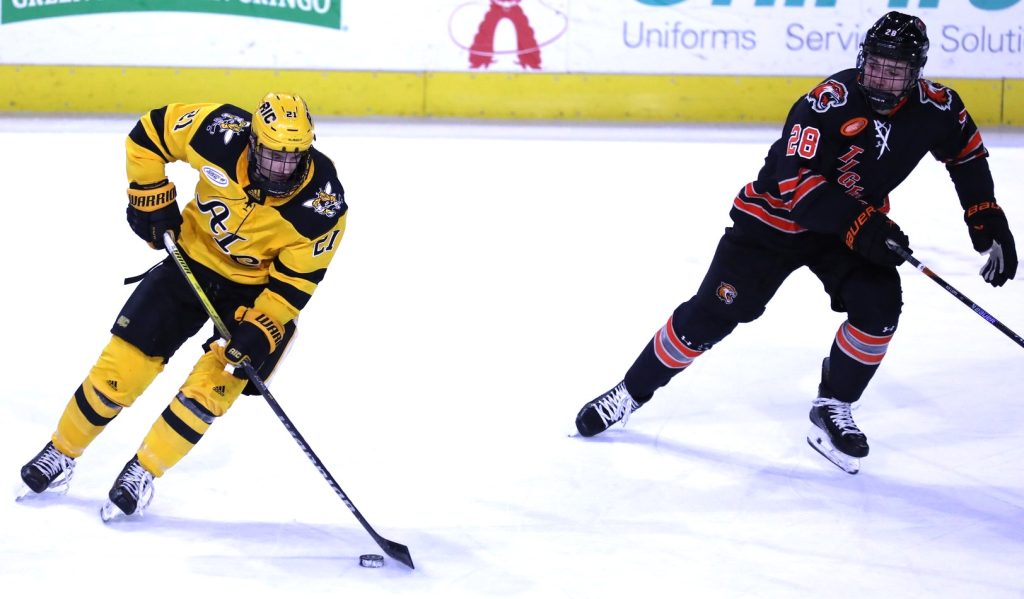
One game for all the marbles.
The longest postseason in college hockey comes to an end on Saturday in Rochester, N.Y. After almost four weeks, the Atlantic Hockey tournament is down to the final two teams: American International and Rochester Institute of Technology. They will play a single game on Saturday in Rochester for the title and the right to represent the league in the NCAA Tournament.
Previewing the finals
No. 5 AIC at No. 1 RIT
We have a classic battle between a resurgent RIT, which has three playoff titles but none since 2016, and AIC, which has won three of the last four, excluding the canceled 2020 postseason.
The Tigers, the regular season champions, dominated their opponents in the quarterfinals and semifinals, dispatching Robert Morris in two games by a combined score of 12-1, and sweeping Niagara by a combined 9-3 tally.
RIT has a wealth of depth, getting scoring from their veteran forwards including Carter Wilkie (16-23-39) and Elijah Gonsalves (17-16-33), and from the blueline (Gianfranco Cassaro’s 17 goals is tops among defensemen in Division I) as well as their all-freshman line of Matthew Wilde, Tyler Fukakusa and Christian Catalano, who have combined for 73 points so far.
In net, Tommy Scarfone is the league’s goaltender of the year, posting a .928 save percentage. He’s allowed a total of four goals in the Tiger’s four playoff games so far.
AIC, hobbled by injuries in February, managed to qualify for the fifth and final bye. They won two hard-fought road series against Air Force and Holy Cross, sweeping the Falcons 3-1 and 3-2 and coming back to defeat Holy Cross in three games 2-5, 3-0 and 3-1.
AIC is playing a more defensive style than in the past due to holes in its roster (although some key players have returned from injury). That starts with rookie goaltender Nils Wallstrom, the Yellow Jackets’ most valuable player so far.
Against Holy Cross last weekend, Wallstrom posted a .959 save percentage and a GAA of 1.33.
The Yellow Jackets are led in scoring by graduate student Dustin Manz (7-24-31) and feature AHA Defenseman of the Year Brian Kramer (10-11-21), who recently returned from injury.
Awards season, final edition
Here is our final set of award winners, which I’m calling “The Rubies” after my buddy Dan Rubin, who covers the ECAC for USCHO.
He continues to call his award picks “The Lerchies” harkening back to the time when he and I shared the Atlantic Hockey beat. Back at you, Dan.
Player of the Year: Liam McLinskey, Holy Cross
This came down to RIT’s Carter Wilkie and McLinskey. Wilkie was last year’s pick by both the league and USCHO, but I went with McLinskey, who led the league in scoring with 47 points on 19 goals and 28 assists. He’s the league’s sole Hobey Baker finalist, announced on Wednesday.
Rookie of the Year: Mateo Giampa, Canisius
Despite a glut of upperclassmen thanks to the extra year available to players due to the pandemic (next season will be the last for this), there was a bevy of rookies who made significant impacts. I chose Canisius’ Mateo Giampa. His 35 points on 18 goals and 17 assists led his team in all three categories.
Coach of the Year: Andy Jones, Bentley
The league finalists are RIT’s Wayne Wilson, whose Tigers repeated as regular season champions, Air Force’s Frank Serratore, whose Falcons improved from 10th last year to fourth, and Holy Cross’ Bill Riga, whose Crusaders continued to improve each season.
But I’m going with Bentley coach Andy Jones, who completed a successful season behind the Falcons’ bench in his first year as a Division I head coach. Despite being hired in late June and inheriting a team picked to finish last, Jones and his team ended up sixth, a point out of a first-round bye. The Falcons are definitely on the upswing.
Looking back, looking ahead
This is my last column of the season, my 25th at USCHO and my 18th covering Atlantic Hockey. I took over the beat from my friend Jimmy Connolly the season following the monumental upset of Minnesota by Holy Cross in the first round of the 2006 NCAA Tournament.
That put the fledgling conference on the map, and so much has changed since then. Air Force and RIT joined my first season covering the league, followed by Niagara and Robert Morris in 2010-11. By my count, four new arenas have opened since then, and the league has gone from 12 scholarships per team to a full complement of 18. The future is bright.
I’m grateful to the coaches, players, and Sports Information Directors who made time for me this season, as well as league SID Todd Bell. Thanks also to editor Matt Mackinder and everyone at USCHO, my hockey family since 1999.
And as always, thanks to my (actual) family for their support and patience while I’m off covering a game, on the phone with a coach, or holed up with my laptop muttering to myself.
And finally, thank you, dear reader. We have a few more journeys together. I’ll be reporting from the championship game in Rochester on Saturday and from St. Paul during the Frozen Four.


